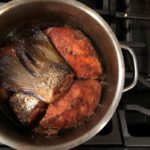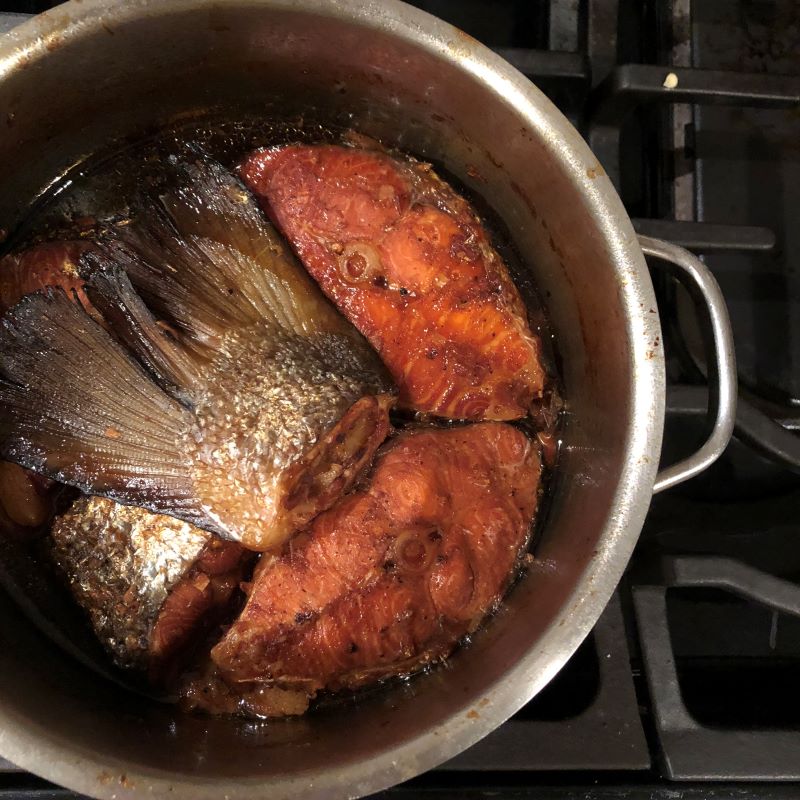
One of staples that I keep on hand to prepare my favorite Vietnamese comfort foods is caramel sauce (nước màu). The inky liquid is the source of savory depth for many homey dishes that are called kho in the Viet repertoire.
If you have my cookbooks, Into the Vietnamese Kitchen or Vietnamese Food Any Day, you likely noticed that I have a lot of kho recipes. They’re that central to the Viet table.
With a jar of caramel sauce, I can make a wealth of simple Viet foods to help me weather the vicissitudes of life. If I'm feeling down or am missing my mom's cooking, I fortify myself with culinary strength. Caramel sauce is among my secret weapons. (The other is fish sauce!). I make the sauce by heart but if you need assistance, see my cookbooks or this video recipe for guidance. The sauce is employed for simmering savory dishes as well coloring dishes into a rich reddish-brown hue.
Salmon and Galangal Pointers
A couple weekends ago when I spotted gorgeous sockeye salmon tail sections labeled “fish heads” at Whole Foods for $2.99 a pound, my mind raced to a salmon kho dish that my parents adore. My mom taught me to simmer the salmon with caramel sauce, fish sauce and galangal (riềng), a relative of ginger that has a bold, spicy menthol note. Salmon isn’t native to Vietnam, but my mom found that it took to the robust flavors of this northern Viet kho remarkably well.
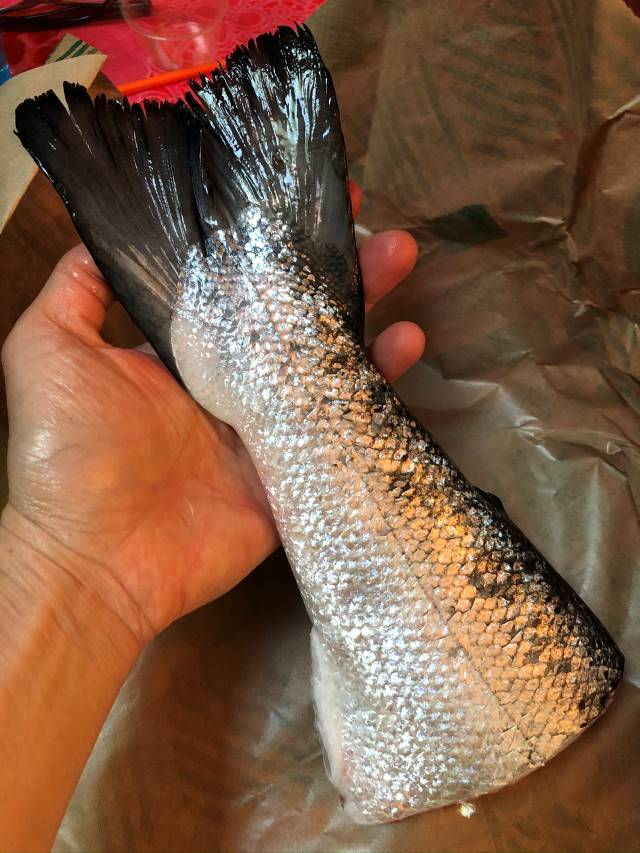
Was the salmon tail really considered fish heads at $2.99 per pound? The fishmonger nodded yes and winked. I bought the larger one. Even though I have a skeletal kitchen, I didn’t even blink at the thought of hacking the fish at home into steaks. The bones toward the tail are not as big as the ones closer to the head! Given our renovation set-up, my husband suggested grilling the tail. I adamantly said, “No, we’re making kho!”
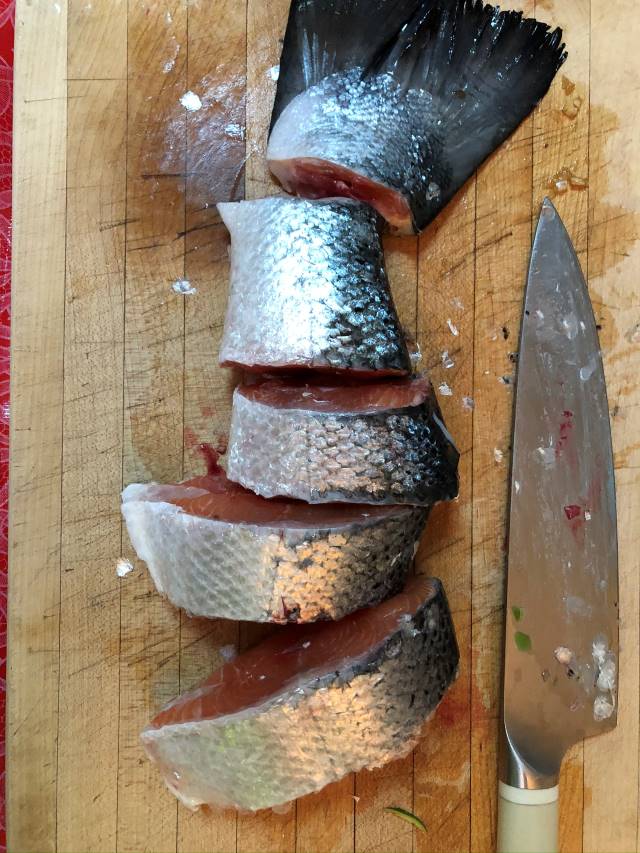
So I cut up the fish with a heavy chef’s knife. It wasn’t easy, but neither was it hard!
I had a chunk of very fatty pork shoulder from another dish to substitute for the fresh pork belly, which you can buy at many mainstream markets nowadays. In a pinch, I suppose you could use 3 to 4 ounces of lightly salted bacon.
I used a 2-quart saucepan that's roughly 8-inches wide to accommodate the steaks as one layer. The thin tail went on top because it can't really sit flat!
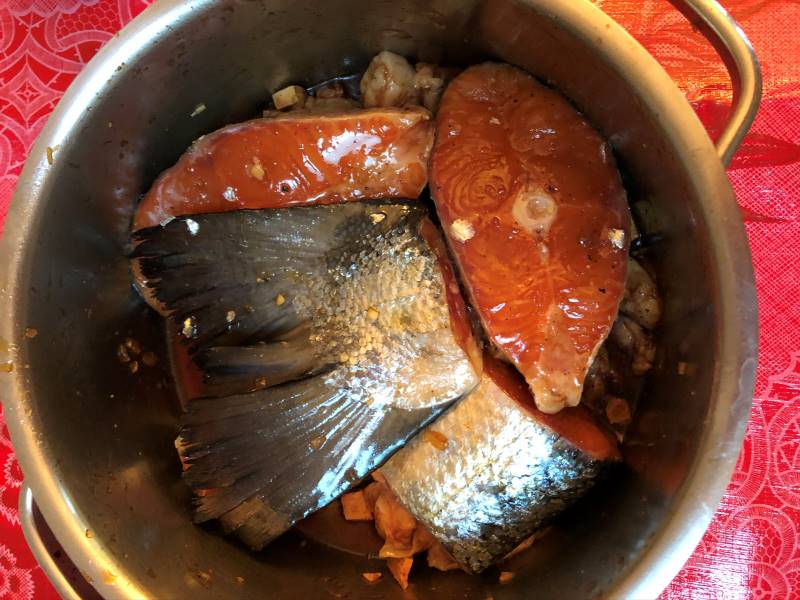
Comfort in a Pot
The result is a fantastic surf-and-turf combination that’s spicy, savory, and a touch sweet. During the long simmering, the fish absorbs all the seasonings and becomes soft and buttery.
When we sat down to dinner with the salmon and galangal kho, rice, and a simple stir-fry of leafy greens, I sighed relief. We ate with gusto and all the stresses of life melted away.
The original version of this recipe appeared in Into the Vietnamese Kitchen (2006). I slightly tweaked it here.
Salmon and Galangal Simmered in Caramel Sauce
Ingredients
- 2 teaspoons brown sugar
- ¼ teaspoon recently ground black pepper
- ¼ teaspoon salt
- 2 ½ tablespoons Caramel Sauce
- 1 ½ tablespoons fish sauce
- 1 ¼ to 1 ½ pounds salmon steaks, each about 1 inch thick
- 6 ounces pork belly, cut into ¼-inch-thick strips and then into 1-inch squares
- 6 to 8 slices fresh galangal, each about ⅛ inch thick, or 3 to 5 slices dried galangal
Instructions
- On a dinner plate or in a bowl, stir together the brown sugar, pepper, salt, caramel sauce, and fish sauce. Add the salmon and coat with the mixture, turning the steaks to make sure that all surfaces are evenly exposed to the seasonings. Set aside for 15 minutes to marinate.
- Select a shallow saucepan in which the fish steaks will fit snugly in a single layer. Arrange the galangal slices on the bottom. Place the fish steaks on top, adding all the seasonings from the plate. Put the pork in the open spaces between the steaks to ensure that it is exposed to all the seasonings.
- Bring to a vigorous simmer over medium-high heat. Adjust the heat to a simmer, cover, and cook for 10 minutes to develop the flavors, checking midway to make sure there is enough liquid in the pan. If the pan seems dry, splash in a little water. During this initial period, the fish will more or less cook in the steam trapped in the pan. Expect the liquid to bubble vigorously. Soft plumes of steam may shoot from under the lid.
- Uncover, add water almost to cover the fish, and bring to a gentle simmer. Cover and cook for 1 hour. Uncover and adjust the heat, if necessary, to continue at a gentle simmer. Cook for another 15 to 18 minutes, or until the liquid has reduced by half and has thickened slightly, forming a sauce.
- Taste the sauce and adjust the flavor with a pinch of sugar to remove any harsh edges, or a sprinkling of fish sauce for more savory depth. Carefully transfer the fish to a shallow bowl. Don’t worry if the steaks break up a bit. Surround the fish with the pork pieces, pour the sauce over the fish and pork, and serve. To eat, put a piece of the fish on your rice and spoon on a bit of sauce.













